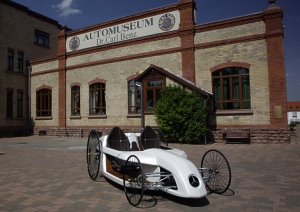
Automotive Intelligence - the web for automotive professionals and car enthusiasts
May 06, 2009
This Week:
-
Another Wedding in Heaven? Porsche and Volkswagen consider to merge
-
Ferrari California: Asian market debut at Shanghai International Motor Show
-
Following the trail of Bertha Benz: F-CELL Roadster on the historic route of Bertha Benz
-
BMW 760Li: the new flagship model with twin-turbo V12 engine and eight-speed automatic transmission
-
Volkswagen brand announces new appointments in global after sales and sales divisions
-
Volkswagen India starts pre-series production of the new Polo
-
Another Wedding in Heaven: Chrysler LLC and Fiat Group Announce Global Strategic Alliance
© 1998 - 2009
Copyright &
Disclaimer
Automotive Intelligence,
www.autointell.com
All Rights Reserved .
For questions please contact
editor@autointell.net
|
Following the trail of Bertha Benz: F-CELL Roadster on the historic route of Bertha Benz The F-CELL Roadster built by apprentices at the Mercedes-Benz plant in Sindelfingen covered a section of the historic route taken by Bertha Benz on the past weekend. Starting in Mannheim, the fuel cell powered car was driven via Ladenburg and Heidelberg.
The symbolic passing of the finish line was at the chemist’s shop in Wiesloch, where Bertha Benz stopped to refuel during the first long-distance journey in automobile history in 1888. Before the end of this year, the company will commence small-series production of the B-Class with a fuel cell drive system. At the end of 2009 the first examples of the smart fortwo electric drive model will also leave the production line to enter service in the "e-mobility Berlin" project early next year. The F-CELL Roadster For around one year, more than 150 apprentices and sandwich course students worked on the design, development, assembly and completion of the F- CELL Roadster. |
|
|
|
The work also involved promising young personnel from the fields of vehicle mechatronics, model-building, electronics, coating technology and production mechanics, as well as product design and interior equipment. The main aim of the project was to integrate the topic of alternative drive systems into the training content in a practical manner. In a unique way, the vehicle links the very latest technologies with the history of automobile engineering. |
As a feature reminiscent of the Benz Patent Motor Wagon of 1886, the car is equipped with large, spoked wheels. The F-CELL Roadster also has styling features from a wide range of automotive eras. These include carbon-fibre seat bases with hand-stitched leather upholstery and a striking glass-fibre front end that takes its lead from Formula 1 racing cars.

Getting fuel
The car is steered using drive-by-wire technology, a conventional steering wheel giving way to a joystick. It is powered by an emission-free fuel cell system installed in the rear. With an output of 1.2 kW, the F-CELL Roadster is capable of a top speed of 25 km/h with an operating range of up to 350 km.
First long-distance journey in automobile history
In August 1888, Bertha Benz and her two sons made a journey from Mannheim to Pforzheim in the Patent Motor Wagon designed by her husband Carl Benz, returning to Mannheim a few days later. This first long-distance journey in the history of the automobile is acknowledged as a pioneering event.
|
|
|
The journey was practically problem-free, with just a few small technical hitches that could all be remedied. The supply of "Ligroin", as petrol was called at the time, gave cause for concern, however, as the 4.5-litre supply in the carburettor – there was no petrol tank as yet – was rapidly dwindling. Ligroin could be purchased from pharmacies in those days, and the town pharmacy in Wiesloch was able to help out. The shop still exists today, and is proud to inform visitors that it was the world’s first filling station.
Photos: Mercedes-Benz
(April 27, 2009)
| .
Homepage News Companies Management Publications Events Guestbook Search . |


